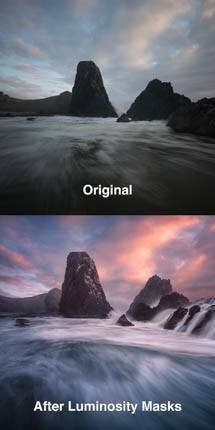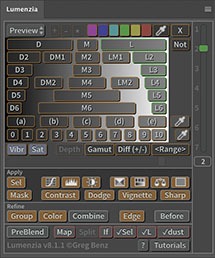Thank you for all the enthusiasm and support for Lumenzia v10. Since it was released, I’ve heard a few common questions that I’d like to address here and in the short tutorial below.
The v10 interface: Compact (the new default) vs Full (the new default)
One of the more common questions has been around the “new” interface. The v10 interface is actually nearly identical to previous versions. Since v8, Lumenzia has offered a few different interface styles to allow you to choose whether you see a larger range of buttons or a simplified, smaller interface. What’s different in v10 is that the default is now set to the “large compact” instead of the full “large” interface, but these options have been around for a couple years (and you’ll see the compact interface is the one I’ve been using for most videos since v8).
You can change the interface size you like either via Flyout (top-right three bars icon) / Interface Size and Modes, or via the shortcut keys on the X button (such as <alt/option>-clicking X to cycle through all 4 options). Aside from the buttons, this also allows access to a small format, which is ideal when want to make the panel as small as possible (such as when working on a laptop).
The sliders allow you to achieve nearly any of the button values (as well as numeric values between the buttons, such as L2.5). So the compact interface offers all the functionality most users need in a smaller and simpler interface. Here are a few quick tips on how to make the most of the compact interface:
- Click on “L” and then slide the precision slider down to the specific value you wish to use (such as L3). I strongly encourage the use of this slider with either interface, so that you may achieve the full range of values (for example, there is no button for L3.5 or L7).
- The alphanumeric zones (such as Zc) include a wider range of tones than the numeric zones (such as Z5). Just slide the precision (vertical) slider down to make something like Zc look more like Z5. There is nothing particularly special about the initial value, so I would encourage you to use these sliders whether you use the compact or full interface.
- There are more numeric zones than the alphanumeric ones. So if you want to target Z5 when coming from Zc, be sure to slide the value (horizontal) slider a little bit right to make the most selected tone be slightly brighter.
However, there are a few benefits to the large interface. You’ll need it for a few buttons (DM1 and LM1), the LIVE-M and LIVE-S modes (since the sliders do not apply), and the buttons offer an easy way to get specific and repeatable previews (which is particularly helpful if you use the Z0 – Z10 zone previews).
v10 modes
In v9 and previous versions, you could use a dropdown to select between modes such as LIVE-M and BlendIf:under. For v10, this has been replaced with a button (as the formatting options for dropdowns in UXP don’t fit the available space). Just click multiple times to cycle through the options. And because BlendIf:this is very rarely used / needed, it is now hidden by default. However, you can go to Flyout / Interface Size and Modes to check it to make it an available option. You can also use this to disable modes you don’t use (for example, uncheck both LIVE options if you’d prefer to quickly cycle between preview and BlendIf modes). The default “preview” mode (which creates the orange preview layers) is required and cannot be disabled.
v10 info display
You can now see import document information (color space and bit-depth) by enabling Flyout / Tool Tips & Info / Document & PS Info. By default, this info is shown in the Basics panel and not the main Lumenzia panel, but you can configure however you like. This new info will show right below the bottom of panel, so be sure to click and drag down the bottom edge far enough to see it. If a low quality setting (such as sRGB or 8-bit) is detected, the display will show in color to help call attention to the issue. While these are great settings for exporting to the web, you wouldn’t want to see this in your original/master files. If you are using an M1 computer under Rosetta, a special warning will be displayed, as running PS natively offers much faster performance.
Create Special Channels / Layers
This is also available in v9, but I have not demonstrated this feature prior to the tutorial here. This feature allows you to create special channels or layers based on LAB values, HSL, etc. This allows a much broader range of targeting options, as well as new creative effects when applied using blend modes. For the latter, use the layer preview option and try the various blend modes for creative effects. Try varying the fill opacity, as some blend modes respond differently to fill vs opacity (this includes the color burn, linear burn, color dodge, linear dodge, vivid light, linear light, hard mix, difference blend modes).
Options for creating special selections (or channels again) are also available via the “Sel” popup (which is shown when you click the button and there is no active selection). So you could use this for example to help create a selection based on different saturation models (HSL vs HSB).
Other shortcuts in the Flyout menu
The Lumenzia flyout menu (top-right three bars icon) now includes helpful shortcuts to the following:
- Written user manuals. Previously these were separate files in the ZIP download for the panel. With the integrated manuals, you now have access to them at any time.
- Release notes: Quick access to see the latest version and what’s changed. (Note that you can always see which version you have installed at the bottom of the panel).
- Check for updates: Quick access to download the latest version. You can always see which version you’re running by looking at the bottom of the panel (click and drag down the bottom edge if you don’t see it).

